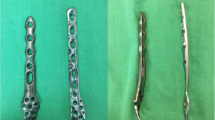Abstract
Purpose
Purpose of this case–control study was to evaluate the feasibility and advantages of arthroscopically assisted reduction and internal fixation of isolated medial malleolar fractures and compare the outcomes with conventional open reduction and internal fixation.
Methods
Forty-seven patients with medial malleolar fractures were grouped into two: arthroscopy-assisted group, and conventional open reduction and internal fixation group. Arthroscopic treatment group consisted of 21 patients. The mean age was 34 years (range: 22–49 years). Conventional open reduction and internal fixation group included 26 patients. The mean age was 42 years (range: 22–58 years). According to Herscovici system, 6 fractures in the arthroscopy group were classified as type-B, 13 fractures as type-C, and 2 fractures were classified as type-D. In both groups, fractures were classified according to Herscovici system. Radiological and clinical outcomes were evaluated according to van Dijk classification and Olerud–Molander scoring system, respectively.
Results
The mean follow-up period was 26 months (18–52 months) for arthroscopically assisted group and 38 months (24–58 months) for the conventional group. According to van Dijk classification, there was only one patient with Grade 1 osteoarthritic changes in arthroscopically assisted group compared with the conventional group where two patients had Grade 2 and one patient had Grade 1 osteoarthritic changes. Median Olerud Scores were 92.3 (75–100) and 86.3 (70–100) for the arthroscopically assisted group and for the conventional group, respectively. The difference was statistically significant (p = 0.015).
Conclusions
With the use of arthroscopically assisted techniques in fixation of isolated medial malleolar fractures, surgeon can evaluate intra-articular surface and reduction that may be of value in the improvement in clinical outcomes over conventional surgical treatment.
Level of evidence
Case–control study, Level III.



Similar content being viewed by others
References
Daly PJ, Fitzgerland RH Jr, Melton LJ, Ilstrup DM (1987) Epidemiology of ankle fractures in Rochester, Minnesota. Acta Orthop Scand 58:537–544
Kralinger F, Lutz M, Wambacher M, Smekal V, Golser K (2003) Arthroscopically assisted reconstruction and percutaneous screw fixation of a pilon tibial fracture. Arthroscopy 19(5):E45
Porter DA, May BD, Berney T (2008) Functional outcome after operative treatment for ankle fractures in young athletes: a retrospective case series. Foot Ankle Int 29(9):887–894
Ramsey PL, Hamilton W (1976) Changes in tibiotalar area of contact caused by lateral talar shift. J Bone Joint Surg Am 58A:356–357
Specchiulli F, Mangialardi R (2004) The surgical treatment of malleolar fractures: long-term results. Chir Organi Mov 89(4):313–318
Ono A, Nishikawa S, Nagao A, Irie T, Sasaki M, Kouno T (2004) Arthroscopically assisted treatment of ankle fractures: arthroscopic findings and surgical outcomes. Arthroscopy 20(6):627–631
van Dijk CN, Verhagen RA, Tol JL (1997) Arthroscopy for problems after ankle fracture. J Bone Joint Surg 79:280–284
Hintermann B, Regazzoni P, Lampert C, Stutz G, Gächter A (2000) Arthroscopic findings in acute fractures of the ankle. J Bone Joint Surg Br 82(3):345–351
Loren GJ, Ferkel RD (2002) Arthroscopic assessment of occult intra-articular injury in the acute ankle fractures. Arthroscopy 18(4):412–421
Panagopoulos A, van Niekerk L (2007) Arthroscopic assisted reduction and fixation of a juvenile Tillaux fracture. Knee Surg Sports Traumatol Arthrosc 15(4):415–417
Carr James B (2003) Malleolar fractures and soft tissue injuries of the ankle. In: Browner BD et al (eds) Skeletal Trauma: basic science, management and reconstruction, 3rd edn. Saunders, Philadelphia, pp 2307–2374
Singh R, Ajuied A, Davies M (2006) Results of early surgical intervention after suboptimal ankle fracture fixation. Injury. 37(9):899–904
SooHoo NF, Krenek L, Eagan MJ, Gurbani B, Ko CY, Zingmond DS (2009) Complication rates following open reduction and internal fixation of ankle fractures. J Bone Joint Surg Am 91(5):1042–1049
Herscovici D Jr, Scaduto JM, Infante A (2007) Conservative treatment of isolated fractures of the medial malleolus. J Bone Joint Surg Br 89(1):89–93
Olerud C, Molander H (1984) A scoring scale for symptom evaluation after ankle fracture. Arch Orthop Trauma Surg 103(3):190–194
Leontaritis N, Hinojosa L, Panchbhavi VK (2009) Arthroscopically detected intra-articular lesions associated with acute ankle fractures. J Bone Joint Surg Am 91:333–339
Takao M, Uchio Y, Naito K, Fukazawa I, Kakimaru T, Ochi M (2004) Diagnosis and treatment of combined intra-articular disorders in acute distal fibular fractures. J Trauma 57(6):1303–1307
Lindjsö U (1985) Operative treatment of ankle fracture-dislocations. A follow-up study of 306/312 consecutive cases. Clin Orthop Relat Res 199:28–38
Marsh JL, Buckwalter J, Gelberman R, Dirschl D, Olson S, Brown T, Llinias A (2002) Articular fractures:does an anatomic reduction really change the result? J Bone Joint Surg Am 84-A(7):1259–1271
Stufkens AS, Knupp M, Horisberger M, Lampert C, Hintermann B (2010) Cartilage lesions and the development of osteoarthritis after internal fixation of ankle fractures. J Bone Joint Surg Am 92:279–286
Imade S, Takao M, Miyamoto W, Nishi H, Uchio Y (2009) Leg anterior compartment syndrome following ankle arthroscopy after Maisonneuve fracture. Arthroscopy 25(2):215–218
Thordarson DB, Bains R, Shepherd LE (2001) The role of ankle arthroscopy on the surgical management of ankle fractures. Foot Ankle Int 22(2):123–125
Ferkel RD, Scranton PE Jr (1993) Arthroscopy of the ankle and foot. J Bone Joint Surg Am 75(8):1233–1242
Aktas S, Kocaoglu B, Gereli A, Nalbantodlu U, Güven O (2008) Incidence of chondral lesions of talar dome in ankle fracture types. Foot Ankle Int 29(3):287–292
Acknowledgments
Authors wish to thank Sibel Kıran, MD, for the statistical analysis.
Conflict of interest
All authors state that they have no conflict of interest.
Author information
Authors and Affiliations
Corresponding author
Rights and permissions
About this article
Cite this article
Turhan, E., Doral, M.N., Demirel, M. et al. Arthroscopy-assisted reduction versus open reduction in the fixation of medial malleolar fractures. Eur J Orthop Surg Traumatol 23, 953–959 (2013). https://doi.org/10.1007/s00590-012-1100-2
Received:
Accepted:
Published:
Issue Date:
DOI: https://doi.org/10.1007/s00590-012-1100-2




